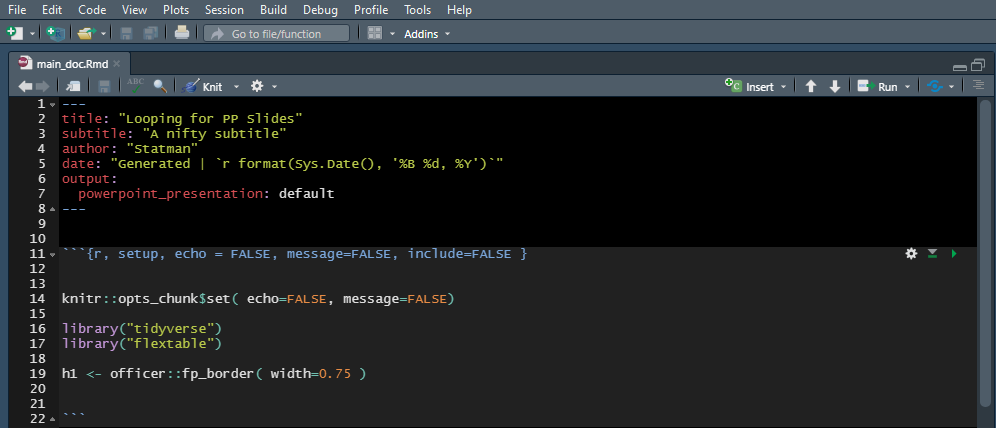

- Rmarkdown presentation how to#
- Rmarkdown presentation install#
- Rmarkdown presentation software#
- Rmarkdown presentation code#
Quotes – Special indentation for your text.Links – Embed URLs to external websites.Style the text – Use italics, bold, strikeout, subscript, superscript, small caps, and verbatim.We’ll now explore what can you do with R Markdown, and how you can do it. It’s popular among developers and technical writers because it provides you with everything you need and nothing else. Markdown is a free-to-use markup language used to format plain text. First, we’ll explore what can you actually do with Markdown.
Rmarkdown presentation how to#
I’ll show you how to spice it up in the sections below.
Rmarkdown presentation code#
layout: true means “this is a slide setting up layout defaults.” class: center centers everything – header text, graphics – unless I specifically code it otherwise. That first slide after the title slide won’t display it’s setting defaults for the other slides. title: "National Weather Service Temperature Forecasts" subtitle: "Boston, San Francisco, and Honolulu" author: "Sharon Machlis" date: "`r format(Sys.Date(), '%B %e, %Y')`" output: powerpoint_presentation: reference_doc: CorporateStyle.pptx - ``` get_interactive_graph(hi_data) ``` - # ()

Here is an R Markdown file that’s a bit more interesting than the default doc, at least for me: One with weather data.

Make sure the three dashes are on a completely new line. That’s done in the doc’s YAML header with the slide_level option, such as output: powerpoint_presentation: slide_level: 3īut if you don’t want to fiddle with all that, you can divide content into new slides manually with three dashes. You can specify another headline level to auto-divide your document into new slides. You don’t need to use that default rule, though. How did R know where to break the content into new slides? The default is “the highest level of headline that’s not followed immediately by another headline.” In this case that’s headline level two, or all titles starting with #. If you save that file and then “knit” it by clicking the knit button in RStudio, you'll get a PowerPoint presentation with the same information. The resulting R Markdown file created by RStudio includes examples for mixing text and R code results. If you click on the second choice, Presentation, you should see an option for PowerPoint under Default Output Format. If you do that from RStudio’s menu with File > New File > R Markdown, you’ll have a few choices. There is an option to create a PowerPoint file from R Markdown when you create a new markdown file in RStudio.
Rmarkdown presentation install#
If your pandoc is too old, try updating RStudio (or install pandoc directly from ). You can run the rmarkdown package’s pandoc_version() function to see if you’ve got it installed and, if so, what version. RStudio ships with Pandoc, so you probably have a version of it installed if you use RStudio.
Rmarkdown presentation software#
It’s not R at all it’s a separate piece of open source software designed for file format conversions.


 0 kommentar(er)
0 kommentar(er)
